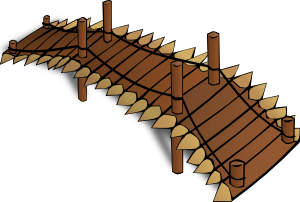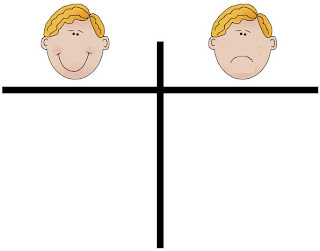"The Agreement Bridge" is a collaborative problem solving strategy that us, as teachers, can use with our students who we are having a difficult time connecting with or who are displaying challenging behaviours in our classrooms. I will note that this is a strategy adopted,
With this in mind, it is possible that we will have those students that we have a more difficult time building relationships with. As such, we may experience difficulties in our classrooms such as a disengaged students, poor attendance, difficulties with homework or classroom procedures, etc. What "The Agreement Bridge" does is that it functions as a means for students and teachers to learn more about each other and begin to build the basis for a relationship through a game rather than a formal discussion (which most students probably would not find comfortable). The game begins with a ruler in-between the teacher and student to represent a bridge with tokens on each side representing themselves. As the teacher and student answer various questions about themselves and about specific classroom situations they can chose to move their markers across the bridge if they feel as though they can now better relate to one another or keep their marker in the same place if they feel that there is still not a common understanding. The following describes "The Agreement Bridge" strategy as stated by Chris Biffle in the Whole Brain Teaching for Challenging Kids free e-book download.
Mrs. Maestra and Juana sit on opposite sides of a table with a ruler between them. One end of the ruler points at Mrs. Maestra; the other end points at Juana. The ruler represents the “distance” between them. One marker representing Juana, stands at her end of the ruler; the other marker representing Mrs. Maestra, stands at her end of the ruler. (If markers are unavailable, any other small objects maybe used, chalk, paperclips, etc.). The goal of the game is for the two players to participate in a structured discussion that eventually arrives at a mutually satisfactory agreement resolving the problem that separates them.
Mrs. Maestra and Juana have a copy of The Agreement Bridge game board (Appendix) and talk about the subjects it presents. After each subject is discussed, one or both players have the option of moving their markers closer to the center of the ruler if they feel the distance between them has decreased. The game is completed when the markers of both Mrs. Maestra and Juana arrive at the middle of the ruler; this symbolizes that the distance between them has been removed and they are ready to fill out an Agreement
Contract (Appendix).
Mrs. Maestra explains that each topic on the Agreement Bridge game board introduces a new subject for conversation. The subjects are: Hello, Problem, Swap, Smart Choices, Foolish Choices and Change. The players decide who should go first. With shyer students, Mrs. Maestra automatically took the lead. The first player puts a coin on one square on the board, introducing the subject he or she wants to talk about. When the first player is finished talking, the second player puts a coin on the same square and discusses the same subject. When the conversation is completed, the second player moves her coin to another square and talks about the new topic. Essentially, the players engage in follow the leader. First one player chooses a subject and talks about it; then the other player talks about the same subject and, when finished, picks the next subject. The topics may be selected as many times as the players wish. After each topic is discussed, one or both players, if they believe the distance between them has decreased, moves their marker closer to the middle of the ruler.
Having only discovered WBT during the second last week of my student teaching placement, I unfortunately cannot offer any personal experience on this strategy. Obviously I chose to write about it today because it does interest me and I feel that it could work very effectively with early years students and maybe even some middle years students. I feel as though most of our students would love the opportunity to tell us more about themselves and to share stories about what interests them so I think, with some prompts, the Hello square could work really nicely. Something that the e-book also mentions is that this game allows students to see their teachers in a different context because they are learning information about them that they wouldn't normally learn. I feel very strongly that one of the easiest ways to build relationships with our students is for them to see us in multiple settings and to discover that we are actually "real people" and not JUST teachers, haha. Similarly to my post on "The Genius Ladder", once I start student teaching in a week and a half I will make sure to update information once I have tried these strategies with my class.
Check out the Whole Brain Teaching website to see Chris Biffle's instructions in context or check out Chris Biffle's YouTube channel to see this strategy in action.













